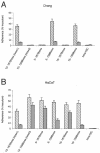Evolutionary and functional relationships among the nontypeable Haemophilus influenzae HMW family of adhesins
- PMID: 15205423
- PMCID: PMC421621
- DOI: 10.1128/JB.186.13.4209-4217.2004
Evolutionary and functional relationships among the nontypeable Haemophilus influenzae HMW family of adhesins
Abstract
Nontypeable Haemophilus influenzae (NTHi) is a common cause of localized respiratory tract disease and initiates infection by colonizing the nasopharynx. Approximately 75 to 80% of NTHi clinical isolates produce proteins that belong to the HMW family of adhesins, which are believed to facilitate colonization. The prototype HMW adhesins are designated HMW1 and HMW2 and were identified in NTHi strain 12. HMW1 and HMW2 are 71% identical and 80% similar overall, yet display differing cellular binding specificities. In the present study we set out to define more clearly the relationships between HMW1 and HMW2 and other members of the HMW family of adhesins. PCR analysis of 49 epidemiologically distinct isolates revealed that all strains possessing hmw genes as determined by Southern analysis contain two hmw loci in conserved, unlinked physical locations on the chromosome. Functional analysis of the HMW adhesins produced by three unrelated strains demonstrated that each isolate possesses one protein with HMW1-like adherence properties and another with HMW2-like adherence properties. These findings suggest that the hmw1 and hmw2 loci may have arisen via a gene duplication event in an ancestral strain. In addition, they support the hypothesis that the distinct binding specificities of HMW1 and HMW2 emerged early and have persisted over time, suggesting an ongoing selective advantage.
Figures







Similar articles
-
The HMW1 and HMW2 Adhesins Enhance the Ability of Nontypeable Haemophilus influenzae To Colonize the Upper Respiratory Tract of Rhesus Macaques.Infect Immun. 2016 Sep 19;84(10):2771-8. doi: 10.1128/IAI.00153-16. Print 2016 Oct. Infect Immun. 2016. PMID: 27430270 Free PMC article.
-
Mapping of binding domains of nontypeable Haemophilus influenzae HMW1 and HMW2 adhesins.Infect Immun. 2001 Jan;69(1):307-14. doi: 10.1128/IAI.69.1.307-314.2001. Infect Immun. 2001. PMID: 11119519 Free PMC article.
-
Conservation and diversity of HMW1 and HMW2 adhesin binding domains among invasive nontypeable Haemophilus influenzae isolates.Infect Immun. 2006 Feb;74(2):1161-70. doi: 10.1128/IAI.74.2.1161-1170.2006. Infect Immun. 2006. PMID: 16428765 Free PMC article.
-
A prototype two-partner secretion pathway: the Haemophilus influenzae HMW1 and HMW2 adhesin systems.Trends Microbiol. 2009 Aug;17(8):355-60. doi: 10.1016/j.tim.2009.06.002. Epub 2009 Aug 5. Trends Microbiol. 2009. PMID: 19660953 Review.
-
The pathogenesis of disease due to nontypeable Haemophilus influenzae.Methods Mol Med. 2003;71:1-28. doi: 10.1385/1-59259-321-6:01. Methods Mol Med. 2003. PMID: 12374015 Review.
Cited by
-
Structural determinants of the interaction between the TpsA and TpsB proteins in the Haemophilus influenzae HMW1 two-partner secretion system.J Bacteriol. 2015 May;197(10):1769-80. doi: 10.1128/JB.00039-15. Epub 2015 Mar 16. J Bacteriol. 2015. PMID: 25777673 Free PMC article.
-
The HMW1 and HMW2 Adhesins Enhance the Ability of Nontypeable Haemophilus influenzae To Colonize the Upper Respiratory Tract of Rhesus Macaques.Infect Immun. 2016 Sep 19;84(10):2771-8. doi: 10.1128/IAI.00153-16. Print 2016 Oct. Infect Immun. 2016. PMID: 27430270 Free PMC article.
-
Analysis of genetic relatedness of Haemophilus influenzae isolates by multilocus sequence typing.J Bacteriol. 2008 Feb;190(4):1473-83. doi: 10.1128/JB.01207-07. Epub 2007 Dec 7. J Bacteriol. 2008. PMID: 18065541 Free PMC article.
-
Genomic sequence of an otitis media isolate of nontypeable Haemophilus influenzae: comparative study with H. influenzae serotype d, strain KW20.J Bacteriol. 2005 Jul;187(13):4627-36. doi: 10.1128/JB.187.13.4627-4636.2005. J Bacteriol. 2005. PMID: 15968074 Free PMC article.
-
Serial isolates of persistent Haemophilus influenzae in patients with chronic obstructive pulmonary disease express diminishing quantities of the HMW1 and HMW2 adhesins.Infect Immun. 2008 Oct;76(10):4463-8. doi: 10.1128/IAI.00499-08. Epub 2008 Aug 4. Infect Immun. 2008. PMID: 18678658 Free PMC article.
References
-
- Alm, R. A., L. S. Ling, D. T. Moir, B. L. King, E. D. Brown, P. C. Doig, D. R. Smith, B. Noonan, B. C. Guild, B. L. deJonge, G. Carmel, P. J. Tummino, A. Caruso, M. Uria-Nickelsen, D. M. Mills, C. Ives, R. Gibson, D. Merberg, S. D. Mills, Q. Jiang, D. E. Taylor, G. F. Vovis, and T. J. Trust. 1999. Genomic-sequence comparison of two unrelated isolates of the human gastric pathogen Helicobacter pylori. Nature 397:176-180. - PubMed
-
- Barenkamp, S. J., and F. F. Bodor. 1990. Development of serum bactericidal activity following nontypeable Haemophilus influenzae acute otitis media. Pediatr. Infect. Dis. J. 9:333-339. - PubMed
Publication types
MeSH terms
Substances
Grants and funding
LinkOut - more resources
Full Text Sources
Other Literature Sources

